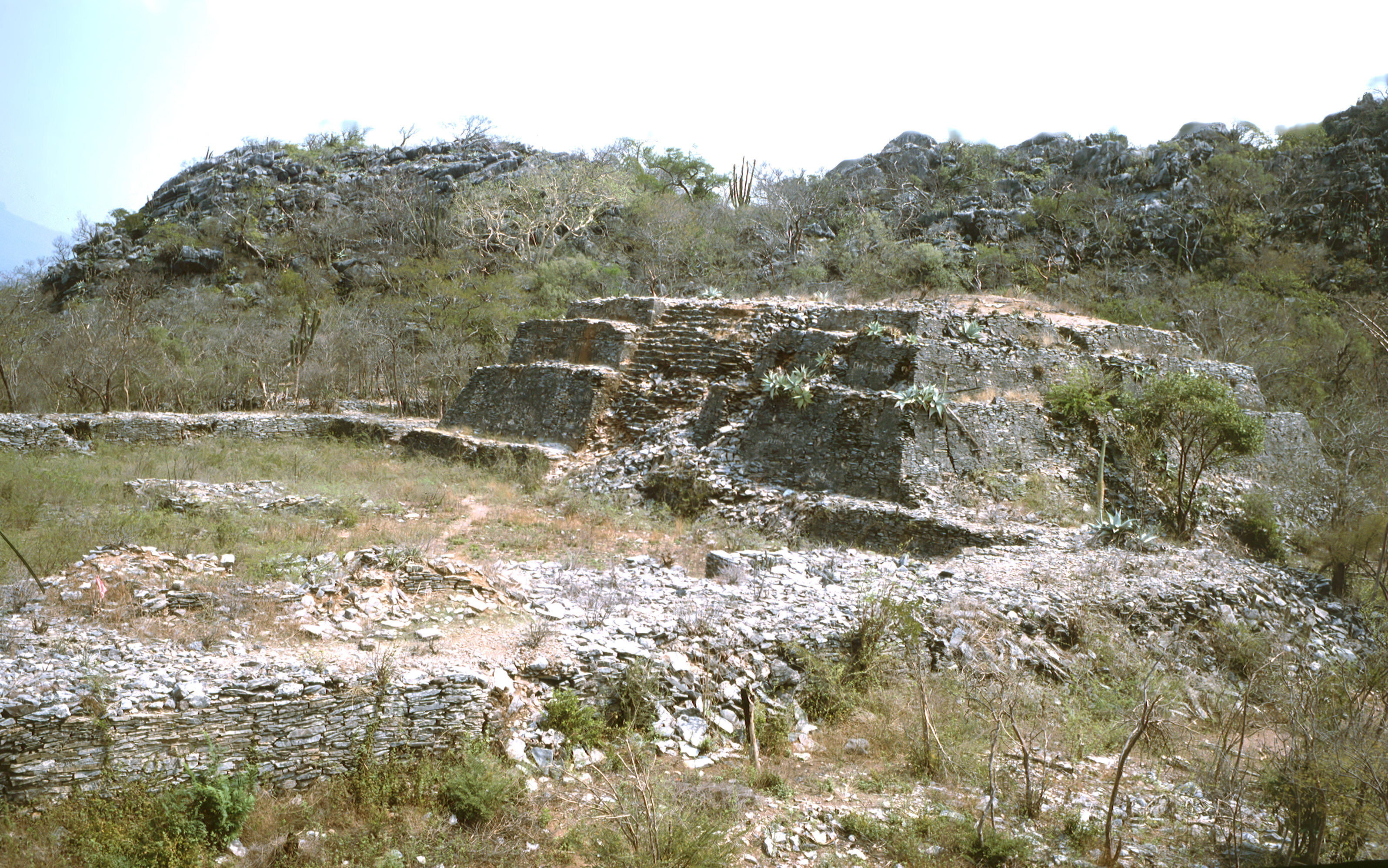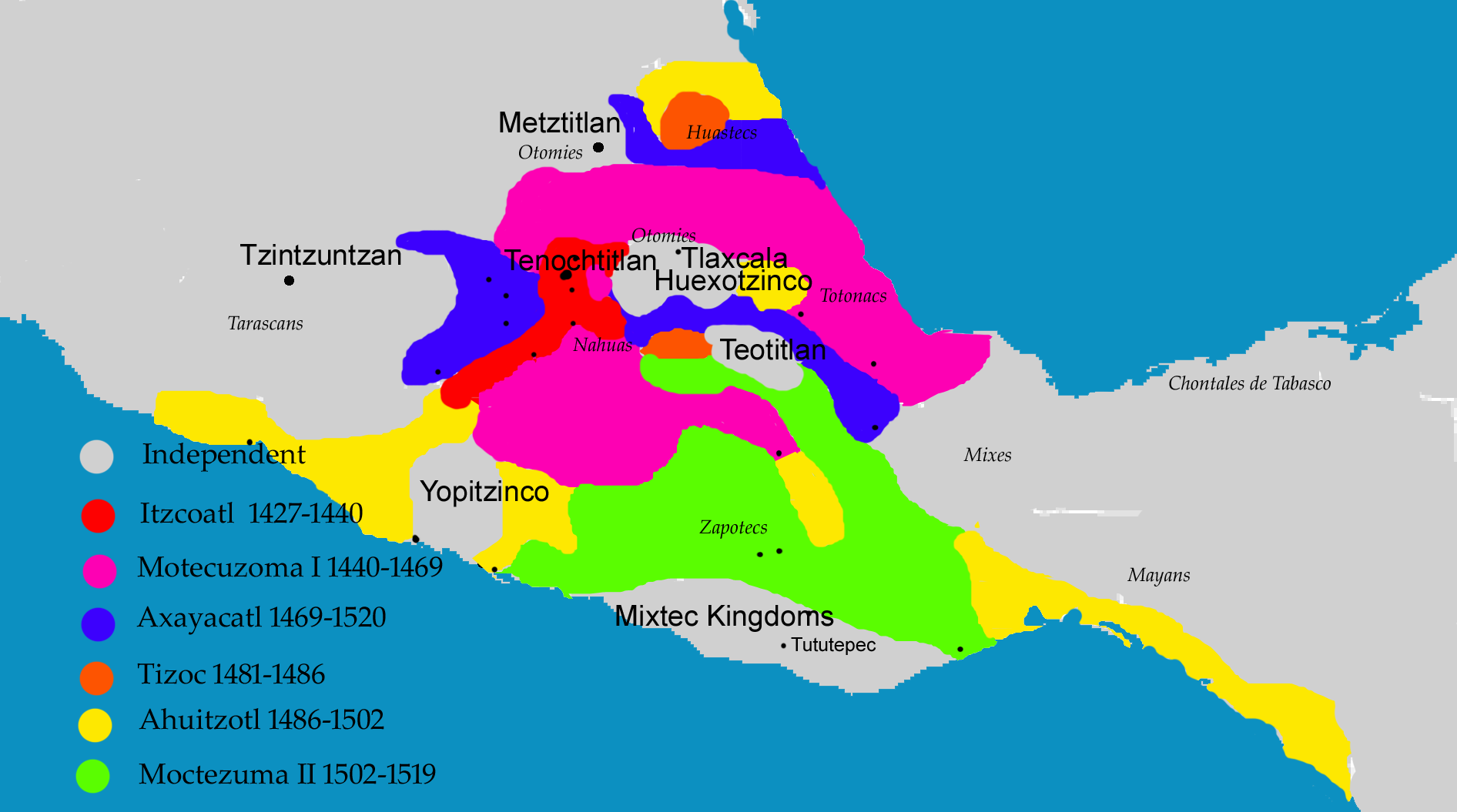|
Cosijopii I
Cosijopii I also Cosiiopii I (December 30, 1502–1563) was the last sovereign of the Zaachila, Kingdom of Zaachila, that was named by the Aztecs as Teotzapotlan. Such kingdom was located in the west side of the current Mexican state of Oaxaca and during the last period reached the Pacific coast of the current Chiapas and Guatemala, the Zaachila Kingdom fell after the Spanish colonization. Cosijopii was the son of Cosijoeza, Zapoteca king, and Coyolicaltzin, daughter of Aztec tlatoani Ahuízotl. His siblings were Bitoopa, Natipa, Pinopia, Cosijopi, and Donají. Cosijopii succeeded his father Cosijoeza to the throne in 1529. Cosijopii moved his capital from Zaachila city to Guiengola at some point in the mid-sixteenth century. His sister, Donají Sicasibí was kidnapped by the Mixtecos and taken to Tehuantepec. He formed an alliance with the Spanish, commanded by Pedro de Alvarado when he arrived in Tehuantepec, and together they fought the Mixtecos. According to the Catholic En ... [...More Info...] [...Related Items...] OR: [Wikipedia] [Google] [Baidu] |
Tehuantepec
Tehuantepec (, in full, Santo Domingo Tehuantepec) is a city and municipality in the southeast of the Mexican state of Oaxaca. It is part of the Tehuantepec District in the west of the Istmo Region. The area was important in pre-Hispanic period as part of a trade route that connected Central America with what is now the center of Mexico. Later it became a secondary capital of the Zapotec dominion, before it was conquered by the Spanish in the early 16th century. The city is still the center of Zapotec culture in the Isthmus of Tehuantepec and is the second largest in the region. The city is known for its women and their traditional dress, which was adopted by Frida Kahlo. Tehuantepec has a reputation for being a matriarchal society. Women dominate the local markets and are known to taunt men. However, political power is still the domain of men. The city experienced a short economic boom in the early 20th century related to a rail line that was built linking the two ocean ... [...More Info...] [...Related Items...] OR: [Wikipedia] [Google] [Baidu] |
People From Oaxaca
The term "the people" refers to the public or common mass of people of a polity. As such it is a concept of human rights law, international law as well as constitutional law, particularly used for claims of popular sovereignty. In contrast, a people is any plurality of persons considered as a whole. Used in politics and law, the term "a people" refers to the collective or community of an ethnic group or nation. Concepts Legal Chapter One, Article One of the Charter of the United Nations states that "peoples" have the right to self-determination. Though the mere status as peoples and the right to self-determination, as for example in the case of Indigenous peoples (''peoples'', as in all groups of indigenous people, not merely all indigenous persons as in ''indigenous people''), does not automatically provide for independent sovereignty and therefore secession. Indeed, judge Ivor Jennings identified the inherent problems in the right of "peoples" to self-determination, as i ... [...More Info...] [...Related Items...] OR: [Wikipedia] [Google] [Baidu] |
1563 Deaths
Year 1563 ( MDLXIII) was a common year starting on Friday of the Julian calendar. Events January–March * January 2 (January 2, 1562 O.S., January 11, 1563 N.S.) – The convocation of bishops and clerics of the Church of England is opened at St Paul's Cathedral in London by the Dean of the Arches, Robert Weston to agree upon the wording of what will become the Thirty-nine Articles, with the assembly adopting all but three of the Forty-two Articles promulgated during the reign of King Edward VI in 1553. The conference lasts for three months before agreeing upon the Articles to be submitted for further modification. * January 25 – In Italy, Instituto Bancario San Paolo di Torino, a constituent of the major financial group Sanpaolo IMI, is founded. * February 1 – Sarsa Dengel succeeds his father Menas as Emperor of Ethiopia at age 14. * February 18 – Francis, Duke of Guise, is assassinated while besieging Orléans by Jean de Poltrot. * Marc ... [...More Info...] [...Related Items...] OR: [Wikipedia] [Google] [Baidu] |
1502 Births
Year 1502 ( MDII) was a common year starting on Saturday of the Julian calendar. Events January–March * January 1 – Portuguese explorers, led by Gonçalo Coelho, sail into Guanabara Bay, Brazil, mistaking it for the mouth of a river, which they name Rio de Janeiro. * January 24 – Commissioners from Scotland and England meet at Richmond Palace in London to finalize an agreement on the marriage between Scotland's King James IV to the daughter of England's King Henry VII, the princess Margaret Tudor, with a dowry of 35,000 Scottish Punnds and an agreement for a "treaty of perpetual peace". The marriage will be completed by proxy on January 25, 1503. * February 12 – Isabella I issues an edict outlawing Islam in the Crown of Castile, forcing virtually all her Muslim subjects to convert to Christianity. * February 13 – The new Viceroy of the New World, Nicolás de Ovando, departs Spain with a fleet of 30 ships and orders to replace Viceroy Franc ... [...More Info...] [...Related Items...] OR: [Wikipedia] [Google] [Baidu] |
Convent Of Santo Domingo (Tehuantepec)
Convent of Santo Domingo may refer to: * Santo Domingo Convent, a convent in Argentina * Convento de Santo Domingo, Cartagena, a convent in Colombia * Convent of Santo Domingo, Cusco, a convent in Peru * Basilica and Convent of Santo Domingo, a convent in Lima, Peru * Convent of Santo Domingo (Girona) or Convent de Sant Domènec de Girona, a convent in Spain * Convent of Santo Domingo (Valencia), a convent in Spain {{disambiguation ... [...More Info...] [...Related Items...] OR: [Wikipedia] [Google] [Baidu] |
Catholic Encyclopedia
''The'' ''Catholic Encyclopedia: An International Work of Reference on the Constitution, Doctrine, Discipline, and History of the Catholic Church'', also referred to as the ''Old Catholic Encyclopedia'' and the ''Original Catholic Encyclopedia'', is an English-language encyclopedia about Catholicism published in the United States. It was designed "to give its readers full and authoritative information on the entire cycle of Catholic interests, action and doctrine". The first volume of the ''Catholic Encyclopedia'' appeared in March 1907 and the last three volumes appeared in 1912, followed by a master index volume in 1914 and later supplementary volumes. Its successor, the ''New Catholic Encyclopedia'', was first published by the Catholic University of America in 1967. ''The'' ''Catholic Encyclopedia'' was published by the Robert Appleton Company (RAC) in New York City. RAC was a publishing company incorporated in February 1905 for the express purpose of publishing the ency ... [...More Info...] [...Related Items...] OR: [Wikipedia] [Google] [Baidu] |
Pedro De Alvarado
Pedro de Alvarado (; 1485 – 4 July 1541) was a Spanish conquistador, ''conquistador'', ''adelantado,'' governor and Captaincy General of Guatemala, captain general of Guatemala.Lovell, Lutz and Swezey 1984, p. 461. He participated in the conquest of Cuba, in Juan de Grijalva's exploration of the coasts of the Yucatán Peninsula and the Gulf of Mexico, and in the conquest of the Aztec Empire led by Hernán Cortés. He is considered the conquistador of much of Central America, including Guatemala, Honduras, El Salvador, and parts of Nicaragua. While a great warrior like Cortes and other conquistadors, Alvarado developed a reputation for greed and cruelty like many conquistadors, and was accused of various crimes and abuses by natives and Spaniards alike. In 1541, while attempting to quell a native revolt, Alvarado was accidentally crushed by a horse, dying a few days later. Character and appearance file:Pedro de Alvarado (Tomás Povedano).jpg, 200px, 1906 portrait of Alvara ... [...More Info...] [...Related Items...] OR: [Wikipedia] [Google] [Baidu] |
Mixtecos
The Mixtecs (), or Mixtecos, are Indigenous Mesoamerican peoples of Mexico inhabiting the region known as La Mixteca of Oaxaca and Puebla as well as La Montaña Region and Costa Chica Regions of the state of Guerrero. The Mixtec culture was the main Mixtec civilization, which lasted from around 1500 BCE until being conquered by the Spanish in 1523. The Mixtec region is generally divided into three subregions based on geography: the Mixteca Alta (Upper Mixtec or Ñuu Savi Sukun), the Mixteca Baja (Lower Mixtec or Ñuu I'ni), and the Mixteca Costa (Coastal Mixtec or Ñuu Andivi). The Alta is drier with higher elevations, while the Baja is lower in elevation, hot but dry, and the Costa is also low in elevation but much more humid and tropical. The Alta has seen the most study by archaeologists, with evidence for human settlement going back to the Archaic and Early Formative periods. The first urbanized sites emerged here. Long considered to be part of the larger Mixteca r ... [...More Info...] [...Related Items...] OR: [Wikipedia] [Google] [Baidu] |
Zaachila
Zaachila (the Zapotec name; Nahuatl: ''Teotzapotlan''; Mixtec: ''Ñuhu Tocuisi'') was a powerful Mesoamerican city in what is now Oaxaca, Mexico, from the city of Oaxaca. The city is named after Zaachila Yoo, the Zapotec ruler, in the late 14th and early 15th century. Zaachila was home of Donaji- the last Zapotec princess. Zaachila is now a historical location. In the middle is a sizable unexplored pyramid mound where two tombs were found in 1962. These tombs are thought to belong to important Mixtec persons. Zaachila became the final Zapotec capital after Monte Alban fell. The Mixtecs took control of the capital prior to the arrival of the Spaniards. The history of the pre-Hispanic city is unclear. One theory is that the site flourished 1100 and 1521 CE. Another theory is that the city was founded in 1399 and could be compared to Tenochtitlan, as it was a city in the middle of a lake. The full extent of the ancient city is not known either, principally because excavation i ... [...More Info...] [...Related Items...] OR: [Wikipedia] [Google] [Baidu] |
Guiengola
Guiengola is a Zapotec civilization, Zapotec archeological site located north of Tehuantepec, and southeast of Oaxaca, Oaxaca, Oaxaca city on Federal Highway 190. The visible ruins are located between a hill and a river, each carries the name of Guiengola. The name means "large stone" in the local variant of the Zapotec language. There are two main tombs that have been excavated, and both seem to be family interment sites. Both have front chambers that are for religious idols, while the rear chambers are for the burial of important people. The site also has fortified walls, houses, ballgame fields, other tombs and a very large "palace" with remains of artificial ponds and terraces. In the center of the site are 2 plazas, one lower than the other, and 2 pyramids, one to the east and one to the west. Background The Zapotec civilization had its beginnings in the Valley of Oaxaca, Oaxaca valley in the late 6th century BC. The three branches of the valley were divided between 3 diffe ... [...More Info...] [...Related Items...] OR: [Wikipedia] [Google] [Baidu] |
Ahuízotl
Ahuitzotl (, ) was the eighth Aztec ruler, the '' Huey Tlatoani'' of the city of Tenochtitlan, son of princess Atotoztli II. His name literally means "Water Thorny" and was also applied to the otter. It is also theorized that more likely, the animal called ahuitzotl is actually the water opossum, the hand symbolizing its prehensile tail, which otters notably lack. Either Ahuitzotl or his predecessor Tizoc was the first ''tlatoani'' of Tenochtitlan to assume the title ''Huey Tlatoani'' ("supreme ''tlatoani''") to make their superiority over the other cities in the Triple Alliance (Aztec Empire) clear. Ahuitzotl was responsible for much of the expansion of the Mexica domain, and consolidated the empire's power after emulating his predecessor. He took power as Emperor in the year 7 Rabbit (1486), after the death of his predecessor and brother, Tizoc. He had two sons, the kings Chimalpilli II and Cuauhtémoc, and one daughter. Biography Perhaps the greatest known military leade ... [...More Info...] [...Related Items...] OR: [Wikipedia] [Google] [Baidu] |








